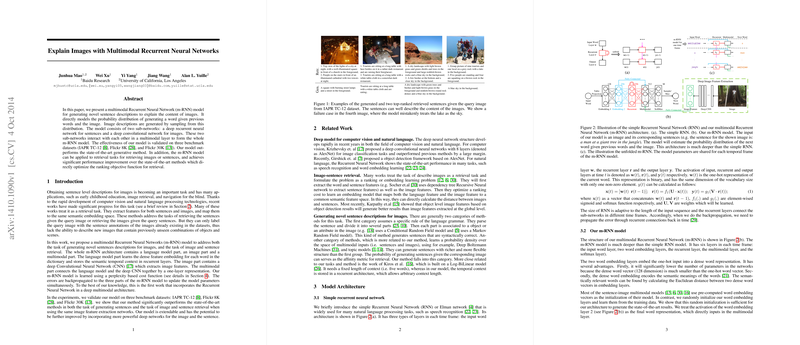Overview of "Explain Images with Multimodal Recurrent Neural Networks"
The paper "Explain Images with Multimodal Recurrent Neural Networks" proposes a novel multimodal Recurrent Neural Network (m-RNN) model designed for generating sentence-level descriptions of images. The model operates by integrating a deep recurrent neural network for sentence modeling with a deep convolutional network for image feature extraction. These two components interact via a multimodal layer, enabling the generation of coherent sentence structures that describe images effectively.
The authors systematically evaluate the m-RNN model on three benchmark datasets: IAPR TC-12, Flickr 8K, and Flickr 30K. Their findings indicate significant improvements over existing state-of-the-art generative methods, particularly in the tasks of sentence generation and image-sentence retrieval, highlighting the robust capability of the proposed model.
Model Architecture
The paper introduces a six-layer architecture for the m-RNN, distinguishing it from traditional RNN setups by adding multimodal functionalities. The architecture features two word embedding layers, a recurrent layer, a multimodal layer, and a softmax layer. The model processes input in a sequence, employing a recurrent mechanism that incorporates an image's context to predict subsequent words. An essential innovation is the use of dense feature embedding for words and images, which bridges the gap between textual and visual modalities, yielding an overview that enriches the descriptive power of generated sentences.
Numerical Results
The results detail remarkable advances in various tasks:
- Sentence Generation: The m-RNN model achieves notable perplexity reductions and BLEU score improvements across datasets when compared to both n-gram baselines and previous state-of-the-art methods like MLBL and Log-BiLinear models. This underscores the model's proficiency in generating accurate descriptions.
- Image and Sentence Retrieval: The model showcases superior performance in retrieving relevant sentences and images, with R@K scores substantially exceeding those of competing methods using similar image features. These results highlight the efficacy of the integrated multimodal approach in matching text and images accurately.
Theoretical and Practical Implications
Theoretical implications of this research suggest a new paradigm for addressing multimodal learning challenges by leveraging the complementary strengths of RNNs and CNNs. Practically, the model holds promise for applications in image captioning, content-based image retrieval, and assistive technologies for the visually impaired, such as generating descriptive content for navigation aids.
Future Directions
While the m-RNN model demonstrates compelling results, several avenues for future research remain open. The adaptation and fine-tuning of more sophisticated image feature extraction techniques, including object detection-based features, present an opportunity for further enhancement. Additionally, expanding the training datasets and refining the LLM could provide more nuanced sentence descriptions and improve generalization across diverse image types.
Overall, this paper charts a clear path forward in the quest to seamlessly blend visual and textual data, advancing the capabilities of artificial intelligence systems in understanding and articulating complex multimodal information.
